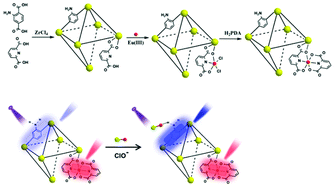Dual-emissive metal–organic framework: a novel turn-on and ratiometric fluorescent sensor for highly efficient and specific detection of hypochlorite†
Abstract
Hypochlorite (ClO−) is widely used as a disinfectant, whose residue content in water should be strictly controlled due to the potential threat to human health in an inappropriate concentration. Herein, dual-emissive metal–organic frameworks with a UiO-66 prototype structure, PDA/Eu/PDA-UiO-66-NH2(x), were elegantly designed and prepared by a mixed ligand assembly and sequential post-synthesis strategy. Since blue emission is sensitive to ClO−, PDA/Eu/PDA-UiO-66-NH2(40) was selected as a model nanosensor for ratiometric and turn-on sensing of ClO− while red emission acts as a reference signal. Remarkably, PDA/Eu/PDA-UiO-66-NH2(40) shows high efficiency and specificity toward ClO− detection, as verified by a very short response time of 15 s, a wide linear range of 0.1–60 μM, a low detection limit of 0.10 μM, and excellent selectivity toward common competing ions. The recovery experiments show that the recoveries of spiking ClO− in tap water range from 96 to 103%. The rigidification of the coordinated H2N–BDC2− ligands should be responsible for the turn-on fluorescence of PDA/Eu/PDA-UiO-66-NH2(40). This work not only shows a highly efficient and specific fluorescent nanosensor for ClO− detection but also presents the first MOF-based fluorescent probe for turn-on and ratiometric sensing of ClO−.



 Please wait while we load your content...
Please wait while we load your content...